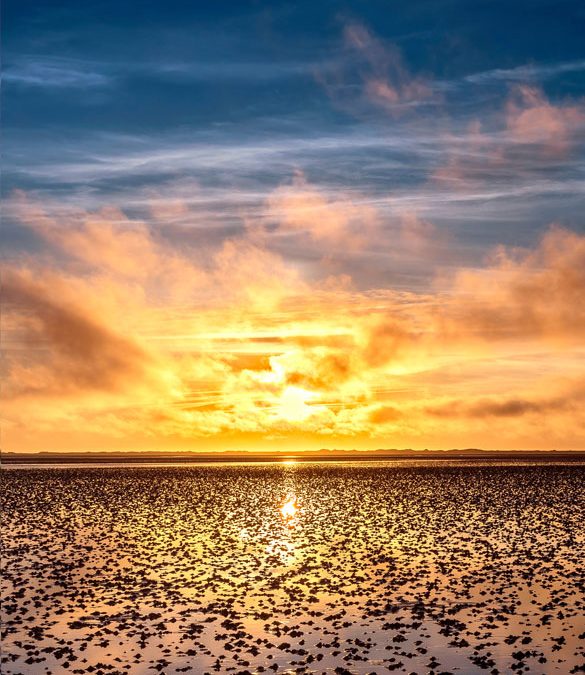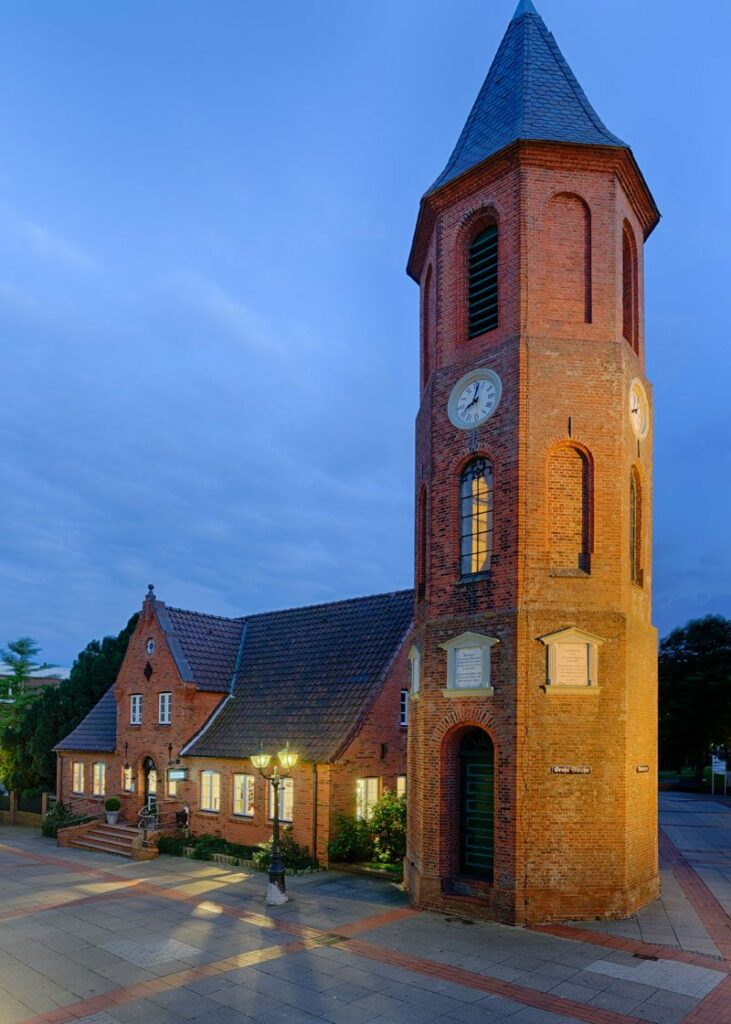
Die Nordseeinsel Föhr ist ein kleines Paradies mitten im Schleswig-
Holsteinischen Wattenmeer, dem größten Nationalpark Deutschlands.
Die Nordseeinsel Föhr ist ein kleines Paradies mitten im Schleswig-Holsteinischen Wattenmeer, dem größten Nationalpark Deutschlands. Entdecken Sie das von der UNESCO ausgezeichnete Weltnaturerbe mit seiner einzigartigen Vielfalt aus 15 km feinsandigem Strand, intakter Natur, gesundem Klima und dem beeindruckenden Schauspiel der Sonnenauf und- untergänge, den scheinbar unendlichen Horizont und einem Himmel, der ständig neue Bilder malt. Kombinieren Sie für ihre Gesundheit das anerkannte Klima des Nordseeheilbads Wyk, mit den wohltuenden Eigenschaften des Meeres.
Von allen Seiten geschützt durch die Inselschwestern Amrum und Sylt und die Halligen, ist Föhr die sanfte, immergrüne Insel. Drei Landschaften lassen sich unterscheiden: Im Kern ist die Insel Geest, ihr Ursprung geht zurück zu den Eiszeiten, davon zeugen mächtige Findlinge im Wattenmeer. Riesige Gletscher formten weiche Hügel und Wellen aus Gestein, Geröll und Sand. Sie tragen heute die älteren Dörfer, die sich wie an einer Schnur über die Insel ziehen. Hier und da winden sich natürliche Wasserläufe durch den Geestrand. Sogar ein kleiner Fluss, die Godel, zerschneiden seinen Rücken..
Der Wind weht meist kräftiger als in anderen Teilen Deutschlands. Nicht ohne Grund sind alle mit dem Wind zusammenhängenden Sportarten bei uns populär.
Richtige Stürme oder Orkantiefs können nur von Oktober bis Februar auftreten. Die Klimawirkung wird durch Jahreszeit und Witterung geprägt. Durch die östliche Lage liegt das Nordseeheilbad Wyk in einer Bucht geschützt vor den zumeist vorherrschenden Nordwestwinden.
The North Sea island of Föhr is a small paradise in the middle of the Schleswig-Holstein Wadden Sea, Germany’s largest national park. Discover the UNESCO World Heritage Site with its unique variety of 15 km of fine sandy beaches, intact nature, healthy climate and the impressive spectacle of sunrises and sunsets, the seemingly endless horizon and a sky that constantly paints new pictures. Combine for their health the recognized climate of the North Sea spa Wyk, with the beneficial properties of the sea.
Protected from all sides by the island sisters Amrum and Sylt and the Halligen, Föhr is the gentle, evergreen island. Three landscapes can be distinguished: At the core is the island of Geest, its origins go back to the ice ages, as evidenced by the mighty boulders in the Wadden Sea. Huge glaciers formed soft hills and waves of rock, boulders and sand. Today they carry the older villages that stretch across the island like a string. Here and there, natural watercourses meander through the Geestrand. Even a small river, the Godel, cut his back.
The wind usually blows stronger than in other parts of Germany. It is not without reason that all wind-related sports are popular here.
Real storms or hurricane lows can only occur from October to February. The climatic effect is influenced by the season and the weather. Due to its eastern location, the North Sea spa town of Wyk is protected in a bay from the mostly prevailing north-west winds.
Schleswig-Holsteinisches Wattenmeer
Das Motto „Natur Natur sein lassen“ und die einzigarte Natur erhalten ist
das Ziel des Schleswig-Holsteinischen Wattenmeers. Zuständig für den
Nationalpark ist die Nationalparkverwaltung in Tönnig.
Die sich den Schutz der Natur mit den Interessen von Einheimischen und
Urlaubern, Landwirten und Seglern, Krabbenfischern, Wattführern,
Wissenschaftlern und vielen anderen zum Ziel gesetzt hat. Die Grenze des
Nationalparks beginnt 150m vor Inselküste und Deichen und nimmt damit
die unmittelbare Uferzone für die traditionelle Nutzung sowie für den
Küstenschutz aus.
Der Nationalpark ist in zwei Schutzzonen unterteilt. Nach dem
Nationalparkgesetz ist grundsätzlich alles untersagt, was der Natur oder
den Tieren und Pflanzen im Nationalpark schaden könnte. Die Zone 1 darf
– im Gegensatz zur Zone 2 – nicht betreten werden. Im küstennahen
Bereich sowie bei geführten Wattwanderungen auf festgelegten
Routen sind Ausnahmen möglich.
In dem Nationalpark Wattenmeer ist eine große Vielfalt an Flora und
Fauna zu finden, die bekanntesten sind wohl die Vögel, zahlreiche
Zugvogelschwärme und Brutvögel zieren die Nordfriesische Landschaft.
Auch Meeressäuger und Fische sind hier zu finden, im Schleswig-
Holsteinischen Wattenmeer sind insgesamt etwa 700 Pflanzen- und 2.500
Tierarten zu finden.
The motto „Let nature be nature“ and the unique nature is preserved the destination of the Schleswig-Holstein Wadden Sea. Responsible for the National Park is the national park administration in Tönnig.
Combining the protection of nature with the interests of locals and holidaymakers, farmers and sailors, shrimp fishermen, mudflat guides, set a goal for scientists and many others. The limit of National parks starts 150m before island coast and dykes and takes with it the immediate shore zone for traditional use and for the coast protection.
The national park is divided into two protection zones. After According to the National Park Act, everything that is nature or could harm the animals and plants in the national park. Zone 1 is allowed – in contrast to zone 2 – cannot be entered. In the coastal area Area as well as guided mudflat hikes on specified Routes are exceptions possible.
In the Wadden Sea National Park there is a great variety of flora and fauna To find fauna, the most famous are probably the birds, numerous Flocks of migratory and breeding birds adorn the North Frisian landscape. Marine mammals and fish can also be found here, in the Schleswig Holstein Wadden Sea are a total of about 700 plants and 2,500 find animal species.

Wie funktioniert
Ebbe & Flut?
Viele Meere, so auch die Nordsee, haben nicht immer einen gleich hohen Wasserstand. Ihr Wasserspiegel steigt und fällt Tag für Tag in regelmäßigen Abständen. Diese regelmäßigen Bewegungen des Wassers werden Gezeiten oder Tiden genannt. Die Gezeiten kommen durch Kräfte zustande, die auf die ganze Erde einwirken, vor allem aber die großen beweglichen Wassermassen in Bewegung versetzt.
Die Anziehungskräfte, die Mond und Sonne auf die Erde ausüben die Fliehkräfte, die dadurch entstehen, dass die Erde und Mond sich drehen.
Es entstehen zwei Flutberge auf der Erde, einer auf dem Mond zugewandten und einer auf der abgewandten Seite. Unter diesen dreht sich die Erde hindurch. Da der Mond an einem Tag 1/28 auf der Umlaufbahn um die Erde weiter gelaufen ist, beträgt der Abstand zwischen zwei Hochwassern nicht nur 12 Stunden, sondern eine knappe halbe Stunde mehr.
Many seas, including the North Sea, do not always have the same water level. Their water level rises and falls at regular intervals day after day. These regular movements of water are called tides or tides. The tides are caused by forces that affect the whole earth, but above all set the large moving masses of water in motion.
The gravitational forces that the moon and sun exert on the earth are the centrifugal forces that result from the fact that the earth and moon rotate.
Two high tides are formed on Earth, one facing the moon and one facing away from it. The earth revolves beneath these. Since the moon continued to orbit the earth 1/28th of the day, the interval between two high tides is not just 12 hours, but almost half an hour more.

Ebbe
Ebbe nennt man das langsame Ablaufen des Wassers und Fallen des Wasserspiegels in einem Meer. Eine Ebbe dauert etwa 6 Stunden und 20 Minuten. Am Ende der Ebbe ist ein sehr niedriger Wasserstand des Meeres erreicht, das (Tide-) Niedrigwasser. Das Wattenmeer ist “trocken gefallen”, und man kann auf dem Meeresboden spazieren gehen. Wasser fließt dann aber noch in den Prielen, die das Watt wie die Flüsse das Festland durchziehen.
Ebb is the name given to the slow draining and falling of the water level in a sea. A low tide lasts about 6 hours and 20 minutes. At the end of the low tide a very low water level of the sea is reached, the (tide) low water. The Wadden Sea has “fallen dry” and you can walk on the seabed. But water still flows in the tidal creeks that run through the mudflats like the rivers through the mainland.

Flut
Flut ist das langsame Auflaufen des Wassers und Steigen des Wasserspiegels in einem Meer. Dies erfolgt in etwa 6 Stunden, also etwas schneller als das Ablaufen des Wassers. Am Ende der Flut ist ein sehr hoher Wasserstand des Meeres erreicht, das (Tide-) Hochwasser. Der “Tidenhub”, der Unterschied von Niedrig- zu Hochwasser, beträgt bei uns etwa 2,9 Meter.
High tide is the slow ebb and flow of water in a sea. This takes about 6 hours, which is a little faster than draining the water. At the end of the tide a very high water level of the sea is reached, the (tidal) high water. The „tidal range“, the difference between low and high tide, is about 2.9 meters here.

„Ungewiß ist,
wohin das
Schicksal führt“
DAS WYKER STADTWAPPEN

Erkunden Sie Wyk auf Föhr
Die Inselhauptstadt Wyk wird seit Mitte des 17ten Jahrhunderts historisch erwähnt. Damals bestand Wyk nur aus einigen Häusern, deren Bewohner hauptsächlich vom Fischfang lebten.Heutzutage erreicht man Wyk über den einzigen Fährhafen der Insel, mittels regelmäßiger Autofähren von dem Festlandhafen in Dagebüll, zusätzlich ist Wyk auch über den Stadtflugplatz per Flugzeug zu erreichen. Die Stadt Wyk hat eine Fläche von 8 km 2 und ca. 4.500 Einwohner – in der Hauptsaison sind allerdings bis zu 20.000 Menschen in der Stadt anzutreffen. Seit dem Jahre 1950 trägt Wyk den Titel Nordseeheilbad. Wyk besitzt einen Leuchtturm, ebenso wie ein Friesenmuseum, das von zwei Walkieferknochen umrahmt wird. Auf dem Friedhof im Stadtteil Boldixum, neben der romantischen Kirche,finden wir zahlreiche sprechende Grabsteine.
The island’s capital, Wyk, has been historically mentioned since the mid-17th century. At that time, Wyk consisted of only a few houses, whose inhabitants lived mainly from fishing. Nowadays, Wyk can be reached via the island’s only ferry port, by means of regular car ferries from the mainland port in Dagebüll, Wyk can also be reached by plane via the city airport. The town of Wyk has an area of 8 km 2 and about 4,500 inhabitants – in the high season, however, up to 20,000 people can be found in the town. Since 1950, Wyk has held the title of North Sea spa. Wyk has a lighthouse, as well as a Frisian museum framed by two whale jawbones. In the cemetery in the Boldixum district, next to the romantic church, we find numerous speaking tombstones.
